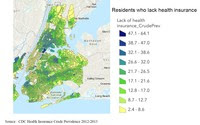Teams will focus on youth age 10 to 21 transitioning from, or at-risk of entering, inpatient care
OMH Commissioner Dr Ann Sullivan said, “Youth ACT teams engage young people with mental illness and their families in their own communities and provide services when and where the young person wants and needs them. The Youth ACT team is a one-stop shop for young people and their families. ACT teams work with individuals to help them develop the skills they can use to lead successful and independent lives, and we are excited to pioneer expansion of ACT to children in New York State.”
The RFP will award funding to create 10 new Youth ACT teams that will serve vulnerable 10 to 21-year-olds in the following counties:
- Monroe
- Erie/Niagara
- Onondaga
- Broome
- Warren/Washington/Saratoga
- Schenectady/Albany
- Westchester
- Nassau
- New York (Manhattan)
- Staten Island
OMH Funding Additional ACT Teams for Youth and Young Adults
In addition to these awards, OMH has already contracted with community agencies to develop four new Youth ACT Teams in Bronx, Kings (Brooklyn), Queens and Suffolk Counties, and recently issued an additional RFP to create a Young Adult ACT Team in New York City and another in Western New York. Young Adult ACT serves individuals 18-to-25 years-old who have not been successfully engaged by the traditional mental health treatment and rehabilitation system.
Youth ACT teams are multi-disciplinary with professional staff including psychiatrists, nurse practitioners, mental health clinicians, and peer advocates. By using a team approach, Youth ACT teams can deliver intensive, highly coordinated, individualized services and skilled therapeutic interventions to ensure the child and their family have the level of treatment and services to support their recovery.
Youth ACT teams are highly responsive and flexible to meet the individualized, changing needs of the child and family, and they offer support 24 hours a day, 7 days a week.
The expansion of Youth ACT represents a commitment by the NYS Office of Mental Health to increase access to services in the home and community for children and youth with mental health issues and their families.
Proposals are due by September 28 and OMH anticipates notifying award winners by October 22. More information on the RFP can be found here on the OMH website.


